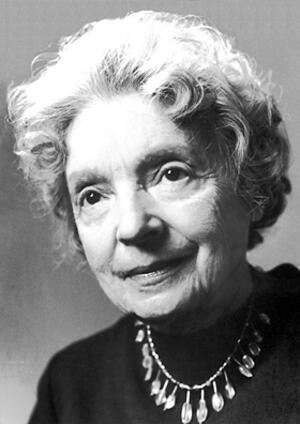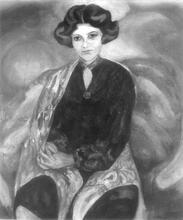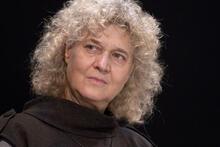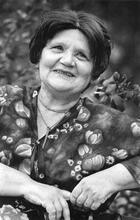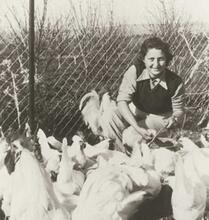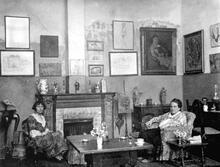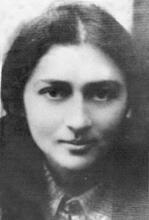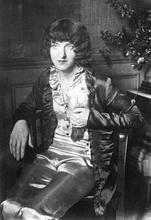Nelly Leonie Sachs
Portrait of Nelly Leonie Sachs in 1966.
From The Nobel Foundation via Wikimedia Commons.
Born in Berlin in 1891, Nelly Sachs was a mature and published writer by the time she and her mother fled to Stockholm in 1940. Yet it was only during Sachs’s 30-year exile in Sweden that her poetry received recognition. While her early writing was informed by German Romanticism, her writing in exile was influenced by her deep desire to bear witness to the victims of the Holocaust. Sachs’s writing was also influenced by Hasidism and Kabbalistic mysticism, topics in which she took an interest after the war. After her mother died in 1950, Sachs sank into a deep depression, and she was hospitalized intermittently between 1959 and 1962 for persecution paranoia. In 1966 she became the first German-speaking woman to win the Nobel Prize in Literature.
Hope and Despair
In 1966, Nelly Sachs became the first German-speaking woman to win the Nobel Prize for Literature, an honor she shared with the Galician-born Israeli novelist Shmuel Yosef Agnon (1888–1970). She was lauded for being the “bearer of a message of solace to all those who despair of the fate of man” and for “her outstanding lyrical and dramatic writing, which interprets Israel’s destiny with touching strength” (website of the Nobel Foundation). For Sachs, a German-Jewish writer exiled to Sweden during World War II, Israel was a community bound by collective suffering and the memory of those murdered in the Shoah, a community that had become a possible homeland for those displaced by war and exile, a “zenith of longing,” where “wonder is heaped/like a storm upon your head,/breaks in your time’s mountains of pain” (O the Chimneys, 1967).
The first lines of this poem from Sachs’ volume of poetry by the same name, O die Schornsteine (O the Chimneys), describe the future of Israel as having been eradicated by genocide and use images she witnessed in the media and learned from personal accounts: “O the chimneys/On the ingeniously devised habitations of death/When Israel’s body drifted as smoke/Through the air.”
Although barely recognized as a writer during her almost 50 years of living in her German homeland, Sachs would bear witness to the victims of the Holocaust and become a voice for those figures whom she described in her poems during her twenty-year exile in Sweden—the “rescued,” the “onlookers,” and also the “murderers.” Writing in a letter that death had been her teacher, Sachs attributed her survival in exile to her writing. She described the “metaphors” in her poetry as “wounds” and transformed the language of mourning and memory into poetic testimonials to the dead as well as to the living.
The recurring images found in Sachs’s poetry, such as fingers, hands, butterflies, stars, and birds, form brilliant constellations that dare to imagine the unthinkable and the unspeakable. Like the works of Gertrud Kolmar and Rose Ausländer, Sachs’s poetry is a lyrical form of communication that monumentalizes both the possibility of atrocities committed by humankind and the beauty of humanity. Sachs’s poetry mourns yet does not despair of humankind.
Early Life
Nelly Leonie Sachs was born on December 10, 1891, in Berlin, the only child of the inventor and industrialist William Sachs (d. 1930) and Margareta (Karger) Sachs (d. 1950). The family belonged to the Jewish community in Berlin but did not attend synagogue or celebrate Jewish holidays. Although Sachs received a private education at her comfortable bourgeois home and at a private girl’s school in Berlin, it was her father who instilled in her a love of music, dance, and literature. Her first ambition was to be a dancer, a passion that would lend a fluid rhythmic quality to her writing.
As a young girl Sachs wrote puppet plays and poetry inspired by the German Romantic writers she cherished. She was not influenced by the Expressionist poetry popular in Berlin at this time and therefore was not widely recognized for her first book of stories, Legenden und Erzählungen (Legends and Tales, 1921) or for the poems she published in a variety of publications. The author Stefan Zweig (1881–1942), however, did recognize the young poet’s talents and arranged for one of Sachs’s poems to be published. When she was fifteen years old, she was inspired by Gösta Berling (1891), the saga by the Swedish novelist and Nobel Prize winner Selma Lagerlöf (1858–1940), with whom she initiated a 35-year correspondence.
Sachs’s first published poem appeared in the October 1929 issue of the newspaper Vossische Zeitung. Although little is known of Sachs’s love at seventeen for a young man who would later be transported to a death camp, her feelings of loss and loneliness were chronicled in the poetry she wrote during and after this time (Bahti and Fries, 1995).
Nazi Germany and Emigration to Sweden
After her father’s death in 1930, Sachs lived with her mother and became an active member of the Berlin Jüdischer Kulturbund (Jewish Cultural Society), where she gave poetry readings and kept company with the poet Gertrud Kolmar. During this time antisemitism was taking on more violent forms. Sachs was traumatized and unable to speak for five days after being interrogated by the Gestapo and after she and her mother witnessed their apartment being plundered by the Gestapo and their wives. In the one prose text, “Leben unter Bedrohung” (Life under Threat), which Sachs published in the journal Ariel (1956), she wrote that her “voice fled, because it didn’t know an answer anymore” (Bower, 2000). In Sachs’s poem Als der große Schrecken kam (When the Great Terror Came), the narrator is silenced by horror like a fish, a “fish with its deathly side/turned upward” (O The Chimneys).
In 1940 Sachs and her mother were able to secure one of the last flights to Stockholm with the help of German friends, Prince Eugen of the Swedish Royal House (1865–1947), and Selma Lagerlöf, who died before Sachs’s arrival. Sachs’s remaining family was murdered in the extermination camps. Once in Sweden, Sachs mastered the Swedish language and was able to support herself and her aging mother in the one-room apartment they shared for the first seven years by writing poetry and translating into German the works of Swedish poets Gunnar Ekelöf (1907–1968), Erik Lindegren (1918–1996), and Johannes Edfelt (1904–1997).
Writing in Exile
Although she had neither gone to synagogue nor taken part in Jewish ceremonies in Germany, Sachs had been deeply influenced by the Hasidic stories of Martin Buber (1878–1965). In Sweden she became fascinated with Kabbalistic mysticism and the writings of Gershom Scholem (1897–1982) on Jewish mysticism and the Zohar. For Sachs, writing was linked to the mystical and became what biographer Kathrin Bower described as “momentary manifestations of Divine Presence in the world [that] indicate a path to transcendence” (Bower, 11).
Sachs’s 1947 poetry collection In den Wohnungen des Todes (In the Dwellings of Death) is made up of early testimonial poems that focus on the suffering of the people of Israel and on the metamorphosis of humankind. The death of Sachs’s mother on February 7, 1950, heightened the feelings of isolation and depression from which she had suffered for much of her life. Sachs was treated for persecution paranoia between 1959 and 1962 at the Beckomberga sanatorium (Ruth Dineson, quoted in Bahti and Fries).
Sachs’ 1951 tragedy Eli: Ein Mysterienspiel vom Leiden Israels (Eli: A Mystery Play of the Suffering of Israel) makes reference to motifs from Hasidic books and tells of an eight-year-old Polish boy and the search for his murderer (Ruth Dineson, quoted in Bahti and Fries). Eli became an acclaimed radio play in Germany after Sachs’s Swedish friends made it public by sponsoring a private edition of 200 copies.
Sachs viewed her time in exile as one in which it was her duty to bear witness to the voiceless victims murdered in the Shoah. Her use of the German language to write poetry became her only tie to her former homeland. In her 1959 collection Flucht und Verwandlung (Flight and Metamorphosis), she writes of her poetry as a spiritual entity that transcends nationality and geography: “I hold instead of a homeland/the metamorphoses of the world” and of herself: “The sick butterfly/will soon learn again of the sea” (O the Chimneys). It is in exile that Sachs confronted her relationship with Judaism and reassessed her identity as a Jew and as a German writer. Sachs did not view exile as a solution; instead she referred to herself in her poem Chor der Wandernden (Choir of Wanderers) as one of many “wanderers” who carry the burden of their exile like luggage to the new country. Sachs describes those in exile as having exposed roots that wilt on the new paths that will never lead to a homeland (Weissenberger, 1976). The 1962 volume of poetry, Zeichen im Sand (Signs in the Sand), reveals the further development of Sachs’s themes of flight, exile and metamorphosis.
Awards and Significant Friendships
Before gaining international fame with her Nobel Prize, Sachs won numerous awards including the Prize of the Club of Swedish Poets in 1958, the Droste-Hülshoff Prize in 1960, the Literature Prize of the City of Dortmund in 1961, and the Peace Prize of the German Book Trade in 1965. The City of Berlin named Sachs an honorary citizen in 1967.
Throughout her life Sachs maintained friendships and correspondences with other internationally acclaimed German-speaking authors such as Ingeborg Bachmann (1926–1973) and Paul Celan (1920–1970), who confronted the Holocaust in their poetry and prose. Bachmann, who had not experienced the Holocaust personally but who was deeply affected and transformed by it, wrote about her reactions to the atrocities committed in Austria and against fascism in her poetry and novels. Bachmann, who met Sachs during a reading tour to Zurich and Meeresburg in 1960, had been greatly moved by her work from the time at which she had first read it, in the 1950s. The Bukovinian Jewish German-speaking writer Paul Celan from Czernowitz had experienced the horrors of Auschwitz and had survived physically but not psychically and confronted his encounter with horror in his writing. Sachs and Celan admired each other’s writing and were friends for over sixteen years until her death, a literary relationship chronicled in a book of their exchange of letters, Briefwechsel: Paul Celan–Nelly Sachs, published in 1996. Celan wrote a poem in Sachs’s honor, “For Nelly Sachs,” after meeting her in person for the first time in 1960.
Nelly Sachs died of cancer on May 12, 1970, only a few days after her friend Celan committed suicide in Paris. In 2010, the native Berliner’s poetic work was honored on the 40th anniversary of her death in an exhibit at the Jewish Museum Berlin. The associated traveling exhibit included stops in Stockholm, Zurich, Frankurt, and Dortmund and featured furniture and belongings as well as audio and video recordings of the writer. In 2016 a German 70-cent postage stamp was issued to commemorate Sachs’s 125th birthday.
Sachs had made evident in her drama Eli that the future could not be built on the ruins of hatred and revenge; instead she hoped that her poetry would be an agent of healing and a source of renewal. Her belief that remembrance provides strength for a more peaceful future permeates her work and demonstrates the relevance of her poetry for the present.
Selected Works
Legenden und Erzählungen. Berlin: F. W. Mayer, 1921.
In den Wohnungen des Todes. Berlin: Aufbau, 1947.
Von Welle und Granit (translated from Swedish). Berlin: Aufbau, 1947.
Sternverdunkelung. Amsterdam: Bermann-Fischer, 1949.
Aber auch diese Sonne ist heimatlos. Darmstadt: Büchner, 1957.
Der Schattenfischer. Berlin: Büchner, 1959.
Nelly Sachs zu Ehren. Gedichte, Prosa, Beiträge. Frankfurt am Main: Suhrkamp, 1961.
Fahrt ins Staublose. Die Gedichte der Nelly Sachs. Frankfurt am Main: Suhrkamp, 1961.
Zeichen im Sand. Die szenischen Dichtungen der Nelly Sachs. Frankfurt am Main: Suhrkamp, 1962.
Poesie, Frankfurt am Main: Suhrkamp, 1962.
Ausgewählte Gedichte. Frankfurt am Main: Suhrkamp, 1963.
Glühende Rätsel. Frankfurt am Main: Suhrkamp, 1964.
Späte Gedichte. Frankfurt am Main: Suhrkamp, 1965.
Die Suchende. Frankfurt am Main: Suhrkamp, 1966.
O the Chimneys. New York: Farrar, Straus, and Giroux: 1967.
The Seeker and Other Poems. New York: Farrar, Straus, and Giroux, 1970.
Teile Dich Nacht. Frankfurt am Main: Suhrkamp, 1971.
Suche Nach Lebenden. Frankfurt am Main: Suhrkamp, 1971.
Selected Poems: including the verse play ‘Eli’. London: Cape, 1968.
Briefe der Nelly Sachs. Frankfurt am Main: Suhrkamp, 1984.
Briefwechsel: Paul Celan–Nelly Sachs. Frankfurt am Main: Suhrkamp, 1996.
Nelly Sachs. München: Text + Kritik, 1979.
Collected Poems I:1944-1949. Los Angeles, CA: Green Integer, 2011.
Agnese, Barbara, ed., Marie Luise Kaschnitz, Hilde Domin and Nelly Sachs. Salzburger Bachmann Edition: “über Grenzen sprechend.” Die Briefwechsel Ingeborg Bachmanns mit Marie Luise Kaschnitz, Hilde Domin und Nelly Sachs. Frankfurt a. M.: Suhrkamp Verlag, 2023.
Bahr, Ehrhard. Nelly Sachs. Munich: Beck, 1980.
Bahti, Timothy and Marilyn Sibley Fries, eds. Jewish Writers, German Literature: The Uneasy Examples of Nelly Sachs and Walter Benjamin. Ann Arbor: University of Michigan, 1995.
Beil, Claudia. Sprache als Heimat: Jüdische Tradition und Exilerfahrung in der Lyrik von Nelly Sachs und Rose Ausländer. Munich: Tuduv, 1991.
Berendsohn, Walter. Nelly Sachs: Einführung in das Werk der Dichterin jüdischen Schicksals. Darmstadt: 1974.
Blumenthal, Ilse Weiss. Begegnungen mit Else Lasker-Schüler, Nelly Sachs, Leo Baeck, Martin Buber. New York: Privatdruck fuer die Freunde der Women's Auxiliary des Leo Baeck Instituts, 1977.
Boland, Eeavan. After Every War: Twentieth-Century Women Poets. Princeton, NJ: Princeton University Press, 2013.
Bower, Kathrin M. Ethics and Remembrance in the Poetry of Nelly Sachs and Rose Ausländer. Rochester, NY: Camden House, 2000.
Dinesen, Ruth. Nelly Sachs: Eine Biographie. Frankfurt am Main: Suhrkamp, 1992.
Falkenstein, Henning. Nelly Sachs. Berlin: Colloquium, 1984.
Fioretos, Ari. Nelly Sachs, Flight and Metamorphosis: An Illustrated Biography. Stanford, CN: Stanford University Press, 2012.
Foot, Robert. The Phenomenon of Speechlessness in the Poetry of Marie Luise Kaschnitz, Günter Eich, Nelly Sachs and Paul Celan. Bonn: H. Grundmann, 1982.
Fritsch-Vivié, Gabriele. Nelly Sachs. Reinbek bei Hamburg: Rowohlt-Taschenbuch, 1993.
Fuchs, Esther. Women and the Holocaust: Narrative and Representation. Lanham, MD: University Press of America, 1999.
Garloff, Katja. Words From Abroad: Trauma and Displacement in Postwar German Jewish Writers. Detroit: Wayne State University Press, 2005.
Holmqvist, Bengt, ed. Das Buch der Nelly Sachs. Frankfurt am Main: Suhrkamp, 1977.
Hoyer, Jennifer M. The Space of Words: Exile and Diaspora in the Works of Nelly Sachs. Rochester, NY: Camden House, 2017.
Kersten, Paul. Nelly Sachs. Hamburg: H. Christians, 1969.
Kessler, Michael and Jürgen Wertheimer, eds. Nelly Sachs: Neue Interpretationen. Tübingen: Stauffenburg, 1994.
Kranz-Löber, Ruth. In der Tiefe des Hohlwegs: Die Shoah in der Lyrik von Nelly Sachs. Würzburg: Königshausen und Neumann, 2001.
Krieg, Matthias. Schmetterlingsweisheit: Die Todesbilder der Nelly Sachs. Berlin: Institut Kirche und Judentum, 1983.
Lehmann, Annette Jael. Im Zeichen der Shoah: Aspekte der Dichtungs- und Sprachkrise bei Rose Ausländer und Nelly Sachs. Tübingen: Stauffenburg, 1999.
Lermen, Birgit and Michael Braun. Nelly Sachs ‘an letzter Atemspitze des Lebens.’ Bonn: Bouvier, 1998.
Martin, Elaine. The Poetics of Silence and the Limits of Representation. Berlin: deGruyter, 2011.
Nyota, Lynda K. “The Space of Words”: Exile and Diaspora in the Works of Nelly Sachs. Rochester, NY: Camden House, 2014.
Rudnick, Ursula. Post-Shoah Religious Metaphors: The Image of God in the Poetry of Nelly Sachs. Frankfurt am Main: Lang, 1995.
Schwedhelm, Karl. Nelly Sachs: Briefwechsel und Dokumente. Aachen: Rimbaud, 1998.
Sowa-Bettecken, Beate. Sprache der Hinterlassenschaft: Jüdisch-christliche Überlieferung in der Lyrik von Nelly Sachs und Paul Celan. Frankfurt am Main: Lang, 1992.
Spalek, John M. Exile, The Writer’s Experience. Chapel Hill: University of North Carolina Press, 1982.
Weichelt, Matthias and Nelly Sachs. Werke. Kommentierte Ausgabe in vier Bänden: Band I: Gedichte 1940-1950. Frankfurt a. M.: Suhrkamp Verlag, 2010.
Weiner, Joshua with Linda B. Parshall. Flight and Metamorphosis: Poems. Nelly Sachs: A Bilingual Edition. Translated by Joshua Weiner with Linda B. Parshall. New York: Farrar, Strauss & Giroux, 2022.
Weissenberger, Klaus. Zwischen Stein und Stern. Mystische Formgebung in der Dichtung von Else Lasker-Schüler, Nelly Sachs und Paul Celan. Bern: Francke, 1976.

